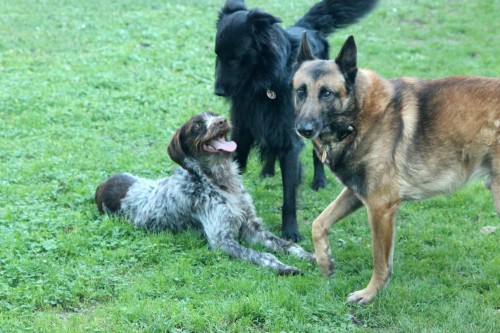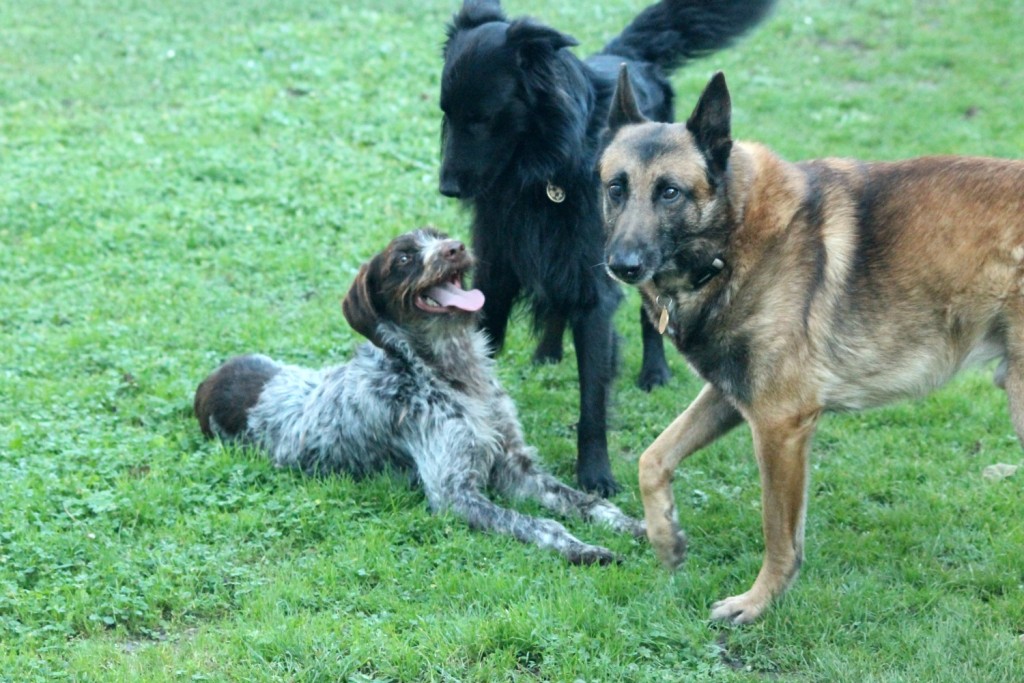If you have new dogs to introduce to each other, don’t leave things to chance. Follow this simple step-by-step guide to harmonious introductions.
- Take into account your dog’s nature. Are they fearful? Are they outwardly aggressive? Do they react when they meet other dogs? You know your dog’s history better than anybody so think of times when you have met other dogs. What you know about your own dogs impacts on everything else you will do here. For instance, my dog Tilly barks at all dogs. Depending on their size, how respectful they are and how scared she is of them, she may bark once or twice or bark for ten minutes. Amigo hates meeting other dogs unless they are on a lead. He rarely goes up to smell them and prefers to be off the lead when meeting others. He hates it if they are bouncy or they have no manners. When you know what your dog likes and doesn’t like, you can tailor your introduction accordingly. I take more time to do it properly with my dogs when there is a potential problem, like my male Heston who is very aggressive towards other dogs in the first seconds of their greeting, especially if they are uncastrated, big or male. With small females, I can ignore all the advice that follows.
- Take into account the other dog’s nature. Dogs who are problems with each other will take far greater time to introduce than if one of them is okay with other dogs. That’s fine. You really can’t take TOO long to introduce dogs. If it goes well, it sets the tone for the rest of their relationship.
- Make sure both dogs are well-exercised before they meet. Don’t be tempted to introduce dogs who have pent-up energy or are in an emotionally-intense moment or place. As a rule, these might be times like feeding time, opening the door, small spaces, cars, getting out of cars. You know yourself when your dog is excited. Make sure introductions happen when you are confident there is no emotional intensity attached to greeting, other than two new dogs checking each other out.
- Make sure you choose a space that is neutral for both dogs. Take them to a completely different environment but allow each dog to have ten or fifteen minutes without seeing the other dog. This will ensure they don’t greet a new dog when they are carrying all the emotional intensity of the fear and excitement attached to a new venue.
- Make sure you allow yourself plenty of time for the introduction: you know it will go badly when you are short of time!
- Keep leads on at all times and check that leads and harnesses are secure.
- Take only high-value treats with you. It’s a one-off, so sausages, ham, chicken and cheese are all permitted.
- Bring a dog-savvy friend, partner or family member with you who knows your dog. Ask them to take the dog you know least well. You know your own dog and at least you can manage one set of behaviours. If you have an extremely aggressive, fearful or reactive dog, you may want to hire a dog behaviouralist for this first meeting to ensure it goes well.
- Start at a distance where you can see each other but both dogs are under control. To know whether your dog is under control or not, you should be able to distract them with a squeaky toy or a treat. This might be a good five hundred yards or more, and this is fine. Start walking, both in the same direction, allowing the gap to get smaller and smaller. Don’t be afraid to stop if your dog is getting over-excited. Back up or walk away if needs be. Wait until you can get their attention and give them a treat. It does not matter if this process takes all afternoon or even three or four weeks, or even months! It is so important to only introduce the dogs when you know you have the ability to keep them a little under control at least.
- Get nearer and nearer. Stop within about 5m of each other and if you have been doing training with your dog, such as ‘sit’ or ‘paw’, now is a good time to get back into that and give them lots of rewards. If they look at the other dog without lunging, barking or growling, reward them with a treat. Don’t worry if this step takes five minutes or an hour. Don’t allow the dogs to greet each other or sniff bums or faces. I’ve even seen people shoving their dogs under the noses of other dogs as if to say “say hello!” when it is clear the dog feels vulnerable or afraid. These situations are most likely to escalate quickly.
- Allow a little light sniffing – dogs sniff bums and faces, and both are acceptable. If you notice one dog trying to put its head or paws above the other’s back, call them away. Don’t allow over-excited humping as that can go badly wrong. You’ll notice the dogs start to urinate too so allow the other dog to smell and sniff. Walk side by side with the dogs, keeping them on a lead that will allow you to pull them back if necessary, out of harm’s way.
- Take a walk with the two dogs together, keeping side by side and allowing plenty of time for them to see each other and assess each other’s energy levels. Enjoy it though, and chat to them, chat with your friends, stop them with treats. Your aim is to make this as positive an experience as possible. Looking at the other dog should be rewarded, as should good manners and gentle behaviours. Bear in mind that your dog is probably not going to listen to you at this point unless you have done loads of socialisation classes with them, and that’s okay. If it starts to get emotional or intense, back up, walk away. You can try again later or try another day. There is no rush.
- Take the dogs back home in separate cars if you can or in separate spaces if not. Make sure they are able to be split up. Cars are small spaces and are emotionally charged places, so fight potential is high.
- Introduce dogs into your garden and home on the lead and don’t let them off until you are happy that they are confident with each other. If they don’t play, don’t worry. Not all dogs like to play with each other and that’s fine. Don’t worry if they are not interested in each other, either. They’re just sussing each other out. Times for concern are when one dog is not exhibiting good doggie manners, being over-energetic, smelling the other dog excessively. This is when you need the dogs under your control. Watch for them doing the doggie shake – it’s a great stress reliever and it means they’re feeling less tense.
- Watch out for small, enclosed spaces. These can be most terrifying for dogs in new relationships, where they can’t put distance between themselves.
You can also read more here


